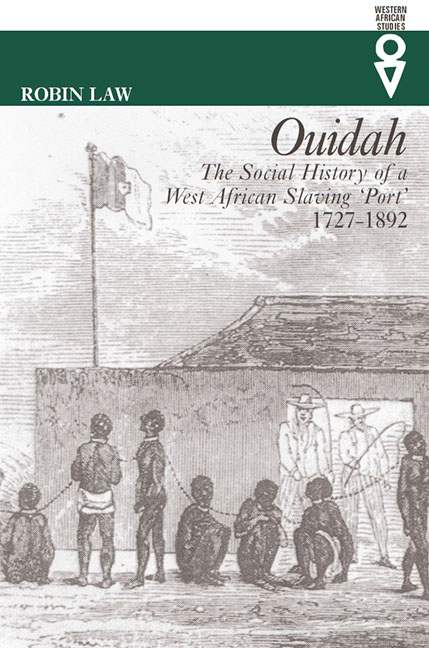Book contents
- Frontmatter
- Dedication
- Contents
- List of Maps & Tables
- Acknowledgements
- Abbreviations
- Map
- Introduction
- 1 Origins: Ouidah before the Dahomian conquest
- 2 The Dahomian Conquest of Ouidah
- 3 Dahomian Ouidah
- 4 The Operation of the Atlantic Slave Trade
- 5 De Souza's Ouidah The era of the illegal slave trade 1815 –39
- 6 The Era of Transition From slaves to palm oil 1840–57
- 7 Dissension & Decline Ouidah under King Glele 1858–77
- 8 From Dahomian to French Rule 1878-92
- Sources & Bibliography
- Index
- Frontmatter
- Dedication
- Contents
- List of Maps & Tables
- Acknowledgements
- Abbreviations
- Map
- Introduction
- 1 Origins: Ouidah before the Dahomian conquest
- 2 The Dahomian Conquest of Ouidah
- 3 Dahomian Ouidah
- 4 The Operation of the Atlantic Slave Trade
- 5 De Souza's Ouidah The era of the illegal slave trade 1815 –39
- 6 The Era of Transition From slaves to palm oil 1840–57
- 7 Dissension & Decline Ouidah under King Glele 1858–77
- 8 From Dahomian to French Rule 1878-92
- Sources & Bibliography
- Index
Summary
Under Dahomian rule, Ouidah remained a major centre of the Atlantic slave trade, albeit at a lower level of exports than under the Hueda kings. In other respects, the town's commercial importance was enhanced by the Dahomian conquest; in particular, whereas earlier most of the actual business of trading had been transacted at the Hueda capital Savi, with Ouidah serving merely as a place of storage for slaves and goods in transit to and from the coast, the conduct of the trade was now concentrated wholly at Ouidah. One consequence of this is that the documentation of events and conditions in Ouidah from European records becomes much more substantial and detailed for the period of Dahomian rule, enabling a more solidly documented and rounded presentation of the life of the community. Moreover, although Ouidah remained subordinate, now to the kings of Dahomey at Abomey, its political importance was also greatly enhanced. With the appointment of a viceroy from 1733, it became the seat of Dahomian provincial administration and of the principal military garrison in the coastal area; in effect, it now replaced Savi as the political centre of its local region. Dahomian Ouidah was thus a much more important (and larger) town than it had been under Hueda rule.
The town and its inhabitants
Ouidah in the second half of the eighteenth century consisted of six quarters: the original Hueda settlement of Tove on the east; the three quarters linked with the European forts, Docome, Sogbadji and Ahouandjigo; the newly established Dahomian administrative quarter of Fonsarame, on the north; and the military garrison, commanded by the Caho, to the north-west. In this period, for the first time, we begin to get some detailed sense of the town's physical layout and size. Its layout is depicted in a map of 1776, which shows the French, English and Portuguese quarters as still distinct settlements around the periphery of the main conurbation, and the garrison under the Caho in a separate encampment in the countryside (see Map 4).
- Type
- Chapter
- Information
- OuidahThe Social History of a West African Slaving Port 1727-1892, pp. 71 - 122Publisher: Boydell & BrewerPrint publication year: 2017

